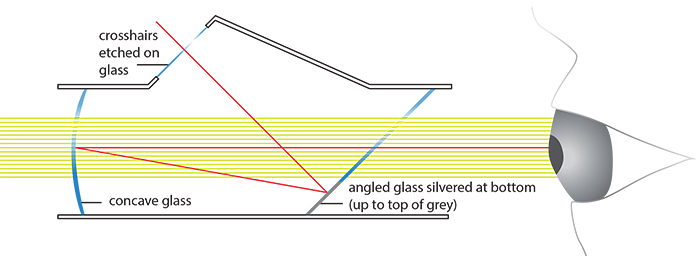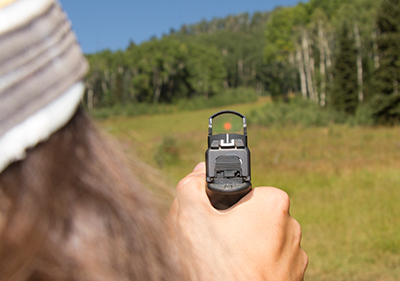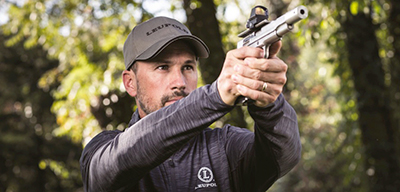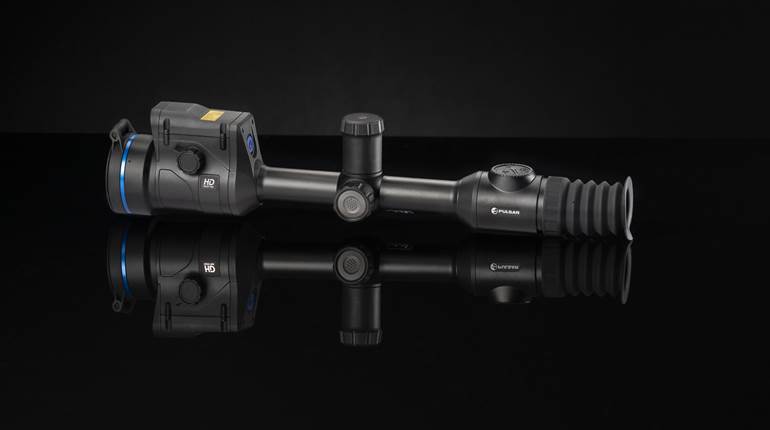
A Trijicon RMR (far l.) is mounted on the S&W Performance Center Ported M&P. Leupold’s DeltaPoint, shown atop the FN America FNX-45 Tactical, is thinner than other reflexes and is the only unit that fits the Kahr Arms Gen2 Premium TP9 and TP45.
It wasn’t that long ago when Picatinny rails were new to rifles. What did we do before them? Well, we didn’t mount riflescopes on our ARs very swiftly, for one. Yet competitive shooters would not be denied the vast benefits of optics, and so they rigged them to their guns however they could—often with the help of professional gunsmiths and custom-machined mounts. Manufacturers took note and began integrating slotted rails atop AR receivers, and the Picatinny design was more or less accepted across the board. Now optics on ARs are as common as white on rice.
A similar evolution is happening right now with handguns. Again, it was the competitive shooters who started it, but the movement required the miniaturization of reflex, or red-dot sights, to make them practical for everyone else. Today, about a half-dozen companies offer handguns with integral mounting solutions for a growing catalog of mini-reflex sights, and the trend is snowballing as shooters of all disciplines discover them. Indeed, when we look back in 20 years, 2015 may just be the year of the mini-reflex revolution.
The Mini-Reflex Concept
The reflex, or reflective, sight is more than a century old and grew into a better gunsight for aircraft and anti-aircraft gunners because it didn’t limit field of view and eye relief like telescopic sights of the time. The sight relied upon an optical system that formed a visual collimator to superimpose a reflected image of a reticle onto a curved lens in the shooter’s line of sight. Whereas a simple reticle that’s etched or wired onto a lens moves in relation to the target as the eye moves, an image of a reticle that is reflected stays on target. What this means is that parallax is minimized.

With this invention, gun sights needed only one focal point rather than a front and rear sight that must be aligned on the target. Its only limitation as a heads-up sighting device was that it depended on light to work.

In the 1970s the reflex sight as we know it was brought to market by the Swedish firm Aimpoint. It contained a battery-powered, light-emitting diode (LED) that allowed these compact, tube-enclosed reflex sights to function in darkness. Its glowing “red dot” soon became this sight’s nickname. It took a little while longer for a few cutting-edge handgunners to discover the red-dot sight’s advantages.

Red Dots On Handguns?
In 1990, a young Doug Koenig won the Bianchi Cup pistol championship, and he did it with a contraption bolted atop his pistol. He was the first to win the cup using an optic of any kind (since then he’s used Aimpoint, Tasco Pro Point II, Leupold/Gilmore and Leupold models), and he’s done it 16 times over. He’s taken 10 world championships and countless other titles. There is no more qualified or outspoken advocate of reflex sights on handguns. Quite simply, Koenig thinks they’re superior to open sights.
“I knew my times with irons, so I had a baseline to test against—the red dot was faster. It’s faster because your focus isn’t bouncing back and forth [between sight and target], and there’s nothing to align,” Koenig said. “You just focus on the target and put the dot on it, just like pointing your finger.”
But speed isn’t the reflex’s only advantage.
“Back in those days we shot a lot of indoor matches in low light,” Koenig said. “The red dots were optimal, and we [fellow red-dot user and pro-shooter Jerry Barnhardt] shot just as well as we did in daylight. Night sights don’t cut it.”
Still, most pros were skeptical of their accuracy; for recreational shooters they were overly bulky and too difficult to mount. Protruding nearly 3" above the bore and averaging more than a pound with mounts, only race gun holsters could accommodate them. Batteries were suspect. Concealability was a joke.
Twenty years later, advancements in circuitry and battery technology allowed engineers to redesign the sights. Deciding that they were more robust than necessary, they stripped them down to the bare minimum of parts—a lens to reflect the reticle image, a power source, LED, circuit board and frame—and tossed everything else. The remaining “mini-reflex sight” (MRS) weighed under 2 ozs., was an inch tall and featured greater field of view thanks to its single lens and tubeless design.
Three-gun competitors latched onto them for a quick, short-range option to mount on their rifles in tandem with their riflescopes. Naturally some advantage-seeking soul realized one would be perfect on a handgun where it would only minimally hamper his vison and the gun’s handling. After all, an MRS is only about 3/4" taller than standard irons. There is no problem holstering MRS-equipped pistols with most open-top, carry-style holsters because the sight doesn’t extend past the ejection port, and as such, holsters have no bearing on it. So, just like that, optics became a viable option for all handgunners.
Mini-Reflex Sights On Practical Handguns
As Koenig described, red-dot-style sights are faster than irons and better in low light. But they’re also more accurate, particularly at ranges past 50 yds., thanks to fine dots and triangles, generally representing 2 to 13 m.o.a., that are more precise than the front posts of modern pistols. The U.S. Army bought thousands of Aimpoints for its service rifles because research showed that it made the average soldier more accurate with less training. Additionally, an infinite field of view makes locating targets and transitioning between them easier. What’s more, with their zero magnification, MRSs are best used with both eyes open to maximize peripheral vision, depth of field and low-light capability. Eye relief is also unlimited, so there’s never worry about mounting locations or getting “scope eye.” But perhaps most notable of all, mini-reflex sights make accurate handgun shooting possible for more people.


Presbyopia And A Game Changer
Presbyopia is the inevitable eye condition caused by aging that prevents the eye from focusing on close objects. I remember when my father said he could no longer see the rear sight, front sight and the squirrel all at the same time and so he had to defile his engraved Browning .22 by topping it with a 4X Weaver scope. Fortunately for him and millions like him, optics “flatten” the sight picture, allowing shooters to focus only on the target and then superimpose the reticle onto it. Focusing on the target is desirable for obvious reasons, such as target identification and anticipation of its movement. For shooters over the age of 40, the advent of mini-reflex sights for handguns may prove to be a game-changer.
What’s more, I’ve found that reflex-style sights will make you a better shooter, because slight imperfections in trigger squeeze and steadiness of hand are made obvious by movement of the glowing red dot. Koenig agrees.
“Red-dots simplify instruction because they allow the student to concentrate on the fundamentals—not keeping the sights aligned,” he said.
Finally, another advantage of some MRS-style sights over other optics is that the shooter can see the iron sights through them—so-called “cowitnessing”—as a backup sighting method. This is possible due to the sight’s low profile. It should be noted that most factory iron sights aren’t tall enough to see through an MRS, but they can be easily replaced with taller ones. If you draw and aim only to realize that the battery is dead or you forgot to turn the unit on, simply use the iron sights through the MRS’ lens and fire away. It is this fact that gave me the confidence to place a mini-reflex on my own carry gun and not worry. Still, battery life is an issue, and that brings me to the next section, because MRSs are not without some trade-offs.
Disadvantages
Most MRSs require batteries—usually one 2032 lithium type. Although some can be left on continuously for a year in moderate temperatures, the possibility exists for all models that the user could find the battery depleted, rendering the sight useless at precisely the wrong time. In addition, said Koenig, “If you have to shoot in a pouring rain, a red-dot sight may put you at a disadvantage.” Also, for as durable and compact as MRSs have become, iron sights still lay the wood to them in both departments. Finally, until recently, mounting an MRS to a handgun meant taking a drill to your new baby. But that last point is well on its way to being a thing of the past.
In 2013 Smith and Wesson released its M&P C.O.R.E. (Competition Optics Ready Equipment) models. Engineers added a couple steps into the CNC-machining process to cut out a 1.92"-long notch in the rear portion of the slide, just ahead of the rear sight dovetail and aft of the ejection port. Then the slide is drilled and tapped to accommodate screws for the five included adaptor plates that match up to several different styles of reflex sights with various footprints and mounting points. The plates feature small studs, or posts, that correspond to holes in the slide and the optic to prevent the sight from shifting laterally. To mount an MRS, simply remove the slide cover, choose the correct plate, secure it to the slide with two included machine screws, then screw the sight onto the plate. Once mounted, the mini-reflex sight is recessed into the slide so it has a lower profile; mounting is quick and secure. Other companies, such as Glock, have emulated this plate adapter system. As a result, optics companies anticipate increased demand and are currently addressing the sights’ aforementioned disadvantages.
For example, Trijicon’s Dual Illuminated RMR, with its Tritium backup light source, works regardless of a battery. Some units, like Bushnell’s First Strike, feature a solenoid that cuts the unit off when the cover is placed on it and dims it in low light, thereby saving battery life. Leupold’s DeltaPoint features Motion Sensor Technology that turns itself off after five minutes of inactivity then immediately turns back on when jostled. Others like Burris’ Fast Fire 3 feature a button for auto-dimming, but on/off is manual. C-More’s CTS features an innovative cover that is attached to a belt -mounted lanyard. When the gun is drawn, the cover pops off, turning the sight on. Raindrops be damned.
Uses And Real-World Experience
As Koenig has proven many times over, mini-reflex sights are superior for “open class” competition, but what about for other purposes?
Using them for concealed carry isn’t as far-fetched as it seemed a few years ago. I mounted an EOTech MRDS on an M&P9L (Longslide), and I was surprised at how concealable it is. My preferred carry method is a small-of-the-back holster inside the waistband. The mini-reflex rests just above my waistband, and does not print under a T-shirt. Ignorantly, I removed the iron sights thinking it’d be one less thing to snag, but after shooting and carrying the gun I quickly learned that a necessity of carrying a reflex-equipped gun is having the ability to cowitness, or see the iron sights through the lens in order to aim if the sight goes down.
I suspect sights will get smaller, and slide recesses will get deeper, allowing the sights to rest even lower to the bore and reducing the number of edges that could catch on clothing. Certainly, large, long-slide pistols such as the Glock G40 MOS are not the first choice of most CCW holders, but other models, such as SIG’s P320 RX and the 4.25"-barreled M&P are well within the realm of concealed carry. Keep in mind, this is just the first wave of optics-ready guns.
For hunting, I mounted a Burris Fast Fire 3 on a Glock G40 MOS. It doesn’t require a special holster and only adds 2 ozs. to the gun. With a solid rest, my 50-yd. groups shrunk from 4.5" to 2.5", and my 100-yd. groups were held within the 6" circle of a whitetail’s vitals. With iron sights, my groups at that range could hardly be called groups.
Despite these things, I still I had a few concerns. One, would it stay zeroed at all times? I have not had one break or lose zero yet, although the 10 mm Auto Glock G40 loosened the screws on a Trijicon RMR—now I always use Lock-Tite. I also found that the tiny machine screws that hold the optic onto the slide cannot go too deeply into the thin metal of the slide as they could strip out. So take great care not to overtighten them during installation.
Many units feature an auto-brightness setting, and for most applications it’s the way to go—but not always. Dimming the dot also makes it smaller, allowing more precise aiming. So aiming in bright light (when you must make the dot big and bright) at long range is difficult.
When shooting from the draw, at first it’s rather easy to pull up, find the target in the optic, but not the red dot. Usually it’s floating around higher than you think, and so you must push the barrel down to see it. After a few minutes of practice, I got it down; now it’s natural.
In time I believe that mini-reflex-ready slides on handguns will be as common as Picatinny rails on rifles. And that is a good thing, as it gives shooters more options.
“There used to be professionals who were skeptical of the red-dot’s speed and accuracy,” Koenig said. “No one doubts them anymore.”
 Kahr Gen2 Premium T9, TP45
Kahr Gen2 Premium T9, TP45
Kahr will initially offer two optics-ready models of its radically new Gen2 Premium line in 9 mm Luger (TP9) and two in .45 ACP (TP45)—with two chambered in .40 S&W likely to follow. In each caliber, one model will come with a Leupold DeltaPoint sight, while the other one will accommodate the DeltaPoint but will not ship with it. All reflex-ready models feature tall sights for cowitnessing. The guns are geared toward competition shooters, employing 5" and 6" barrels and triggers much lighter than those used in Gen1 firearms. Price: $976-$1,576. kahr.com
 Sig Sauer P320 RX, P226 Elite SAO RX, P227RX
Sig Sauer P320 RX, P226 Elite SAO RX, P227RX
SIG Sauer took a different approach in offering a reflex-sight-ready handgun: It branded its own sights, called Romeo 1 and Romeo 3, and offers one in a package with the gun. The company’s RX series handguns accommodate the sights by way of a machined cutout in the slide. The guns also have raised iron sights. That, along with a unique channel made in the Romeo sights, allows unfettered cowitnessing. I fired the P320 RX and found that the Romeo 1 only added to the 9 mm Luger P320’s versatility. It was already a solid, full-size duty gun, but now it’s great for competition and pure fun. The Romeo sights are slightly wider than many mini-reflux sights, but it is simple with two rubber brightness buttons, robust and easy to use. I was twice as accurate at 25 yds. and much faster shooting the SIG topped with the Romeo. I hope SIG will carry the RX concept to its compact models in the future. Price: $913-$1,484. sigsauer.com
 Glock Gen4, G34 MOS, G35 MOS, G40 MOS, G41 MOS
Glock Gen4, G34 MOS, G35 MOS, G40 MOS, G41 MOS
In 2015, Glock released its MOS (Modular Optic System) that uses a 0.196"-deep, 1.929"-long machined slide cutout with four stability posts to mount an optic. All MOS Glocks come with five numbered mounting plates that fit most currently made mini-reflex sights.
The company’s Gen4 G40 MOS in 10 mm Auto is marketed toward hunters, what with its 6" barrel and 9.49"-long slide. Even though it has a 15-plus-one capacity of 10 mm Auto ammunition, it weighs 28 ozs. (unloaded) and 40 ozs. (loaded), which compares favorably to many six-shot revolvers. Plus, with a reflex sight installed, it’s good for low-light situations. In sum, I consider the Glock G40 MOS one of the most versatile consumer handguns ever produced. Its one downside is that it does not come with taller sights for indexing through the optic, so I recommend installing an aftermarket set.
While all of Glock’s MOS models are geared toward competitive shooters and hunters at this time, the company’s national sales manager, Bob Radecki, said that, based on the MOS’ great reception, it’s considering future carry models. Price: $840. glock.com
 Smith & Wesson M&P Pro Series C.O.R.E
Smith & Wesson M&P Pro Series C.O.R.E
S&W offers the C.O.R.E. (Competition Optics Ready Equipment) in its M&P Pro Series line. The M&P9L and M&P40L competition models have long slides and 5" barrels; yet, at the time of this writing, the company also offers the closest thing yet to true optics-ready carry guns in its M&P9 and M&P40 Pro Series C.O.R.E. that weigh 24 ozs. with 4.25" barrels. These guns are the same as the non-C.O.R.E. models, except they feature taller sights, enhanced texture on the palm swell, C.O.R.E. engraving on the slide, and of course, the machined cutout on the slide that accommodates five mounting plates designed to fit the C-More CTS, Trijicon RMR, JP Rifles J Point, Leupold DeltaPoint, Docter and Insight MRDS. Other optics-ready models—such as the gun shown on p. 48 and on this month’s cover—are offered in the Performance Center M&P Ported line.
In shooting the M&Ps, however, I found the taller sights were not tall enough to see through several different sights I tried. Nonetheless, the C.O.R.E. models are wonderful, low-profile, handguns that, like the rest, have no downside other than an extra hundred bucks. If you choose not to use the optic, just take it off and replace the hardly noticeable slide cover. Price: $812. smith-wesson.com
FN America FNX-45 Tactical
FN geared its new optics-ready gun to operators rather than competitors with its FNX-45 Tactical 15-round handgun. Like the others, the American-made gun features a machined cutout in the slide to mount a mini-reflex optic. It also includes sights that are amply tall for cowitnessing. The pistol, which features a 5.3" threaded barrel and weighs 33 ozs. unloaded, comes with two mounting plates to accommodate the RMR and the DeltaPoint. The polymer frame comes in black or flat dark earth. The company has already established itself as a maker of extremely durable polymer pistols, and the addition of an optics-ready gun only lends the line more versatility. Price: $1,399. fnhusa.com
Mini-Reflex Sight Makers
Trijicon RMR trijicon.com
Bushnell First Strike bushnell.com
Leupold DeltaPoint leupold.com
Burris Fast Fire 3 burrisoptics.com
Docter Sight C docter-germany.de
Meopta M-RAD meoptasportsoptics.com
Sight Mark Mini Shot sightmark.com
Vortex Razor vortexoptics.com
TruGlo Dual Color Open Red Dot truglo.com
Eotech MRDS eotechinc.com
JP Enterprises J Point jprifles.com
Steiner MRS steiner-optics.com
Redfield Accelerator redfield.com
Insight 261/PVS insighttechnology.com
SIG Sauer Romeo 1, Romeo 3 sigsauer.com




































